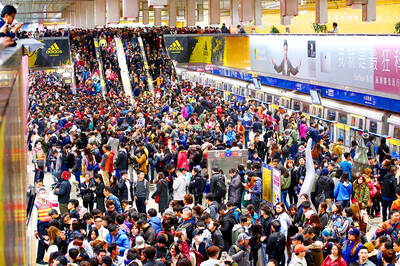An Aboriginal community public health volunteer team that aims to take care of ailing Aboriginal elders using a combination of modern medical technology with traditional cures was officially inaugurated in Taipei yesterday.
The team consists of 188 volunteers, including 80 Aborigines and 123 members who have background in public health.
The 188 volunteers will be stationed in 15 Aboriginal communities around the country.
The program was initiated by Chen Mei-shia (陳美霞), a public health professor at National Chengkung University.
“I’ve been trying to help reform Taiwan’s public health system since it was harshly hit five years ago by SARS,” Chen told a news conference.
“During my research, I realized that minority groups are the most disadvantaged ones in our public health system,” she said.
This inspired her to make public health improvement in Aboriginal communities a major part of her campaign for reform.
However, instead of just bringing medical teams with modern equipment and the best medicine to Aboriginal communities, she wanted to put the “ancient wisdom that is passed on through generations” into the modern public health system.
Kazangnirang Muwakai, a nurse who has served at her hometown public health center in Laiyi Township (來義) for more than 20 years, agreed with Chen’s idea and signed up for the training.
She said she signed up for the Aboriginal community public health volunteer program that began earlier this year because she realized that modern medical technology could not meet all the medical needs, especially psychological ones, of the elderly in her native Paiwan community.
“Some elders in the village don’t feel better after taking medicine when they’re sick,” Muwakai said. “They only feel better after undergoing some rituals by the local shaman.”
Besides treatment by the local shaman, members of local communities use many other traditional cures, with some relying on expert knowledge of various herbs.
“It’s not enough to just record the health conditions of the elders. What’s more important is to take down what they have in their brains,” she said.
The volunteers often visit the elders in the communities. They talk to them and listen to them talk about how some sickness is traditionally cured or about anything that happened around where they live.
Aziman Istasipal, a Bunun volunteer, said that the program had brought some changes in his life, as he learned more about his own culture and history by talking with elders in the tribe.
One such change is that he used his Chinese name when he signed up for the training, but now he asks to be called by his Bunun name.
After the volunteers became more familiar with the elders and gained their trust, they started teaching them about public health concepts.
The program has been quite successful and Chen voiced hope that it would continue to grow in the future.

READY: The CGA said it closely monitored China’s maritime exercise, deployed vessels to shadow the Chinese ships one-on-one and set up emergency response centers Chinese navy and coast guard ships have returned to China, signaling the end of a massive maritime exercise, authorities said yesterday. The Coast Guard Administration (CGA) released images it said showed Chinese vessels sailing north in rough seas past Taiwan on Thursday, on their way to China. “All the Chinese coast guard went back to China yesterday, so although they have not officially made any announcement, we consider it over,” CGA Deputy Director-General Hsieh Ching-chin (謝慶欽) said. Beijing has not confirmed the drills and the Chinese Ministry of National Defense did not say whether the maneuvers had taken place when asked at a

People can take the Taipei MRT free of charge if they access it at Nanjing Sanmin Station or Taipei Arena Station on the Green Line between 12am and 6am on Jan. 1, the Taipei Department of Transportation said on Friday, outlining its plans to ease crowding during New Year’s events in the capital. More than 200,000 people are expected to attend New Year’s Eve events in Taipei, with singer A-mei (張惠妹) performing at the Taipei Dome and the city government’s New Year’s Eve party at Taipei City Hall Plaza, the department said. As people have tended to use the MRT’s Blue or

PUBLIC TRANSPORT: As some roads would be fully or partially closed, people are advised to take the MRT, with services expanded to accommodate more riders This year’s Taipei Marathon, which has obtained its first gold label certification from World Athletics, is to be held from 5am to 1pm tomorrow and would have 28,000 participants. The race is to start from the Taipei City Plaza and would go through major roads throughout the city, with traffic control implemented from 6am to 2pm, officials said. The Taipei Mass Rapid Transit (MRT) system and New Taipei City MRT Circle line would start operating at 5am on the day of the race, they said. The race would cover Renai Road, Xinyi Road, Hangzhou S Road, Aiguo east and west roads,

Taipei is participating in Osaka’s Festival of Lights this year, with a 3m-tall bubble tea light installation symbolizing Taiwan’s bubble tea culture. The installation is designed as a bubble tea cup and features illustrations of Taipei’s iconic landmarks, such as Taipei 101, the Red House and North Gate, as well as soup dumplings and the matchmaking deity the Old Man Under the Moon (月下老人), affectionately known as Yue Lao (月老). Taipei and Osaka have collaborated closely on tourism and culture since Taipei first participated in the festival in 2018, the Taipei City Department of Information and Tourism said. In February, Osaka represented